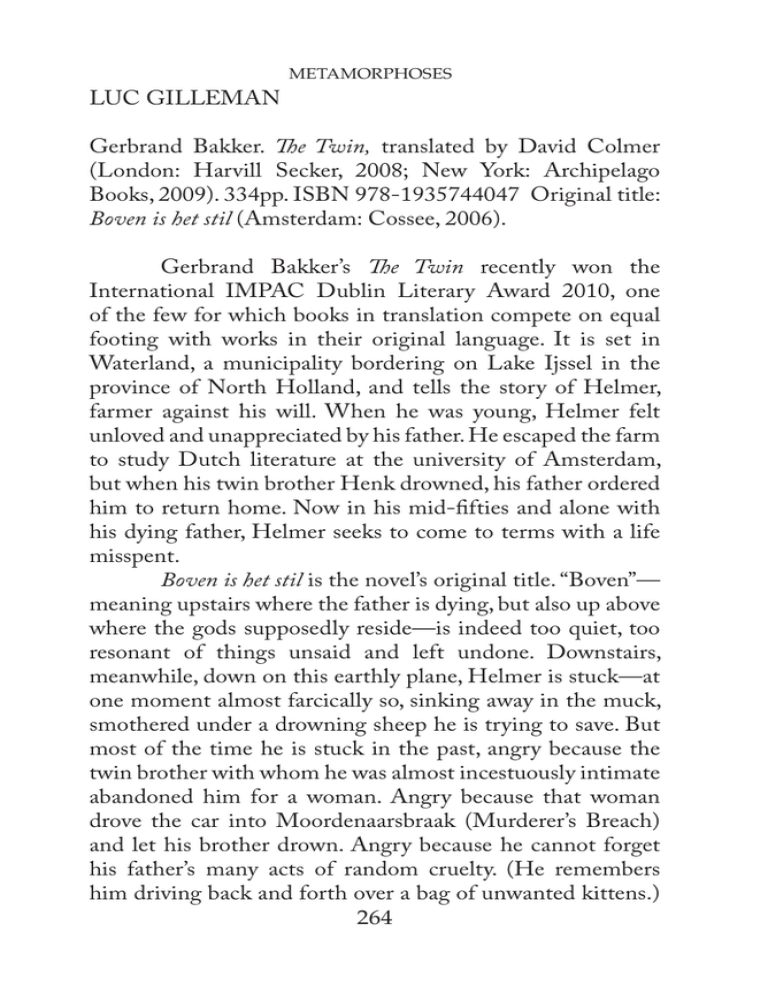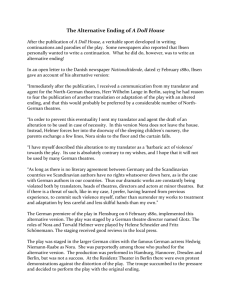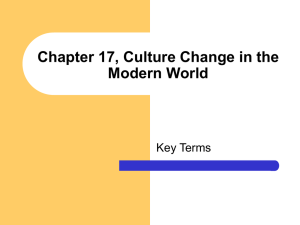LUC GILLEMAN The Twin, (London: Harvill Secker, 2008; New York: Archipelago
advertisement

LUC GILLEMAN METAMORPHOSES Gerbrand Bakker. The Twin, translated by David Colmer (London: Harvill Secker, 2008; New York: Archipelago Books, 2009). 334pp. ISBN 978-1935744047 Original title: Boven is het stil (Amsterdam: Cossee, 2006). Gerbrand Bakker’s The Twin recently won the International IMPAC Dublin Literary Award 2010, one of the few for which books in translation compete on equal footing with works in their original language. It is set in Waterland, a municipality bordering on Lake Ijssel in the province of North Holland, and tells the story of Helmer, farmer against his will. When he was young, Helmer felt unloved and unappreciated by his father. He escaped the farm to study Dutch literature at the university of Amsterdam, but when his twin brother Henk drowned, his father ordered him to return home. Now in his mid-fifties and alone with his dying father, Helmer seeks to come to terms with a life misspent. Boven is het stil is the novel’s original title. “Boven”— meaning upstairs where the father is dying, but also up above where the gods supposedly reside—is indeed too quiet, too resonant of things unsaid and left undone. Downstairs, meanwhile, down on this earthly plane, Helmer is stuck—at one moment almost farcically so, sinking away in the muck, smothered under a drowning sheep he is trying to save. But most of the time he is stuck in the past, angry because the twin brother with whom he was almost incestuously intimate abandoned him for a woman. Angry because that woman drove the car into Moordenaarsbraak (Murderer’s Breach) and let his brother drown. Angry because he cannot forget his father’s many acts of random cruelty. (He remembers him driving back and forth over a bag of unwanted kittens.) 264 FALL 2010 Finally, he is most of all angry with himself for allowing others to stand in the way of his desires. But the story is as much about the landscape and the weather as about these people. This is the Dutch countryside, crisscrossed by causeways where you can ride your bike if you push hard on the pedals and lean into the wind. In summer, vacationers from Amsterdam sail the region’s many lakes and waterways, but, most of the year, the sky hangs low and the land is draped in mist and drizzle. Waterland is “cramped and wet” (60)— a state of mind as much as a physical reality. When its farmers long for vaster horizons and land large enough to accommodate bolder dreams, they turn their gaze northwards to the Waddenzee and the Friesian islands that stretch all the way along the German coast towards Denmark. Some have started up new farms over there. Helmer makes do with a yellowing map of Denmark, pinned on the wall. Every night, he reads out its names: Jutland, Sjaelland, Funen, Odense, Helsingør, Rågeleje—sounds both strange and familiar, reminiscent of the West Friesian spoken in an enclave of North Holland. But Helmer cannot leave. Upstairs, where it is oppressively quiet, his father is taking his time to die. The narrative takes us inwards to the roots of Helmer’s anger and outwards to the landscape Helmer loves more than he is ready to admit. Lined with stunted willows and drained with an ingenious system of modern windmills, the polders of Waterland barely provide for modest sheep and cattle farming. Periodically some of the land is left flooded, surrendered to a variety of graceful long-legged and long-billed birds: oystercatchers, sandpipers, redshanks, and curlews – or, in equally evocative Dutch: scholeksters, strandlopers, tureluurs, wulpen. The novel delights in the power of proper nouns and the poetry of topography. It takes us to polders with names such as Purmer, Beemster, 265 METAMORPHOSES and Wormer, and towns such as Blokdijk, Watergang, Monnickendam,Venhuizen, the very names of which summon up the soggy land and people battling the water. Much of the text is dominated by the present tense, as if it tries to resist the lure of storytelling. Short, declarative sentences enumerate affect-less observations and descriptions: Helmer milks cows, paints rooms, buys furniture, and wipes his father’s bum. Outside, the animals turn their backsides into the wind and dumbly endure the eternal rain. Words fail the enormity of reality. At a funeral, a widow addresses her husband’s casket: “Arie, hij is dood”— Arie: he is dead, is all she manages. At the end of life, there are no stories left, just tautologies. Or as the dying father puts it, “Dead is dead” and “gone is gone” (305). *** In the Dutch-speaking world, Gerbrand Bakker was already known for two etymological dictionaries “for beginners” and a children’s book Perenbomen bloeien wit (1999), successful also in its German translation Birnbäume blühen weiss (trans. Andrea Kluitmann; publ. Düsseldorf: Patmos, 2002). The Twin is being promoted as his literary debut in the English-speaking world, beautifully translated by David Colmer, an Australian who lives in Amsterdam. Colmer, a two-time winner of the David Reid Poetry Translation Prize with translations of Dutch poetry, has a good ear for the music of prose, which is exactly what is needed here. Bakker’s unadorned style harks back to the by now venerable tradition of the “Nieuwe Zakelijkheid,” represented by Ferdinand Bordewijk (1884-1965) in the Netherlands and Willem Elsschot (1882-1960) in Flemish Belgium. It is characterized by short simple statements of facts that are poetically evocative but, all in all, pose few 266 FALL 2010 problems to the translator: Eind maart en de zon is al op als ik begin te melken. Als ik tien koeien heb gemolken, loop ik naar de staldeur. Ergens zit een merel, de mesthoop dampt, de geknotte wilgen zouden morgen kunnen uitlopen. In de jongveestal is het onrustig, maar verder is het zo stil dat ik de ezels kan horen draven in het ezelland. (209) Late March and the sun is already up when I start milking. When I’ve milked ten cows, I walk to the shed door. There’s a blackbird somewhere, the muck heap is steaming, the pollarded willows could sprout tomorrow. The yearlings are restless in the shed, but otherwise it’s so quiet I can hear the donkeys trotting in the paddock. (272) This is a text that calmly breathes. And David Colmer’s translation manages to preserve Bakker’s distinctive rhythm and voice. It is elegant and faithful to the cadence of the original text, though not necessarily faithful to its original significance. “Ezelland” is “donkey land” rather than the neutral “paddock.” For Helmer, who is called “donkey man” by his best friend, it is a sort of fairytale place he identifies as his own. The cows and sheep are his father’s; the donkeys are the only animals that are truly his and that share his capacity for mute endurance. And yet, given the poetry of Bakker’s language, Colmer is justified in preferring the music of assonance in “trotting” and “paddock,” the symmetry of the double syllables, and the succession of voiced and voiceless plosives 267 METAMORPHOSES t, p, d, k. After all, translating is to some extent rewriting, if not reinventing—as well as occasionally sidestepping the culturally untranslatables: Als iemand me bij mijn naam noemde, Helmer, dacht ik er zelf altijd ‘Henk en’ voor. Altijd. Hoe lang hij ook al dood was, onze namen hoorden bij elkaar, als Peek en Cloppenburg, als Kanis en Gunnink, als Van Gend en Loos. (261) When someone addressed me by name, as Helmer, I always added “Henk and” in front of it in my thoughts. No matter how long he had been dead, our names belonged together. (339). Peek en Cloppenburg is an international chain of department stores in Europe. Kanis en Gunnink is a Dutch brand name of coffee. Van Gend en Loos is a Dutch-Belgian transportation company. The translator’s dilemma is obvious: none of these coupled names sound particularly inevitable for the English speaker, as they are meant to be in this passage, and replacing them with a similar set (Marks and Spencer, for instance) would nudge the text out of its cultural niche. Proper nouns tend to resist translation and function as sites of cultural authenticity. This is the case, for instance, with the many place names that feature in the novel. Only when their meaning is too obviously symbolic (as in Murderer’s Breach for Moordenaarsbraak, where Henk gets drowned) does Colmer look for an English equivalent. Puns are another site of resistance. The following dialogue falls flat in English: 268 FALL 2010 ‘Zijn jullie ook boertjes?’ vroeg Jaap aan Teun en Ronald. ‘Broertjes,’ verbeterde Teun hem. (251) “Are you farmers too?” Jaap asked Teun and Ronald. “We’re kids,” Teun corrected him. (328) It seems strange that an older man would ask children if they are farmers. In Dutch, “boertjes” and “broertjes” can be easily mistaken for one another, as they differ by just one letter. But Colmer can hardly be blamed for not finding a solution to a problem that has none. * * * Translation is necessarily a fraudulent affair. It always involves some deception. And like any counterfeiter who wants his copy to be mistaken for the original, the translator hopes that his translation will not sound like one. That, finally, is Colmer’s achievement, for which he deservedly received a quarter of the €100,000 IMPAC award. It is fitting therefore to end this review not with the Dutch text but with a sample of Colmer’s English rendition. “It’s not only quiet upstairs, it’s quiet everywhere,” says Helmer, halfway through the novel; “the rain taps softly on the window ledge, the road is wet and empty. I am alone, with no one to cuddle up to” (150). In the end, Helmer does come to terms with his life. In Dutch, to accept is “aanvaarden.” In one of his etymological dictionaries, Gerbrand Bakker explains that the MiddleDutch anevaerden means not only “to take possession of ” but also “to go on a voyage,” since “varen” means “to sail.” When his father dies, Helmer sells the cows and 269 METAMORPHOSES travels to Denmark where on a deserted hill he looks at the sea and the setting sun. “I am alone” are also the last words of the novel. What he experiences, however, is no longer an oppressive loneliness, but the separateness of one being in harmony with another: Warm air blows across my neck. It’s a while before I realize that it can’t be the wind: wind doesn’t blow in regular, short blasts. Very slowly I turn around. Less than eight inches away, at face height, is the dark head of a lopeared sheep. She looks at me impassively with her yellow eyes, in which the pupils are not round but almost square. Now her breath is blowing in my face, smelling like herbs. This sheep is no sorry creature. This is a noble beast. When I can’t bear the gaze of her yellow eyes any longer, I look forward again. The sheep stays where she is. I imagine that she, like me, is looking at the sky over the sea, which is blue, orange and yellow—almost purple in places. My breathing adjusts to the warm air blowing over my neck in gentle blasts. (34243) 270






